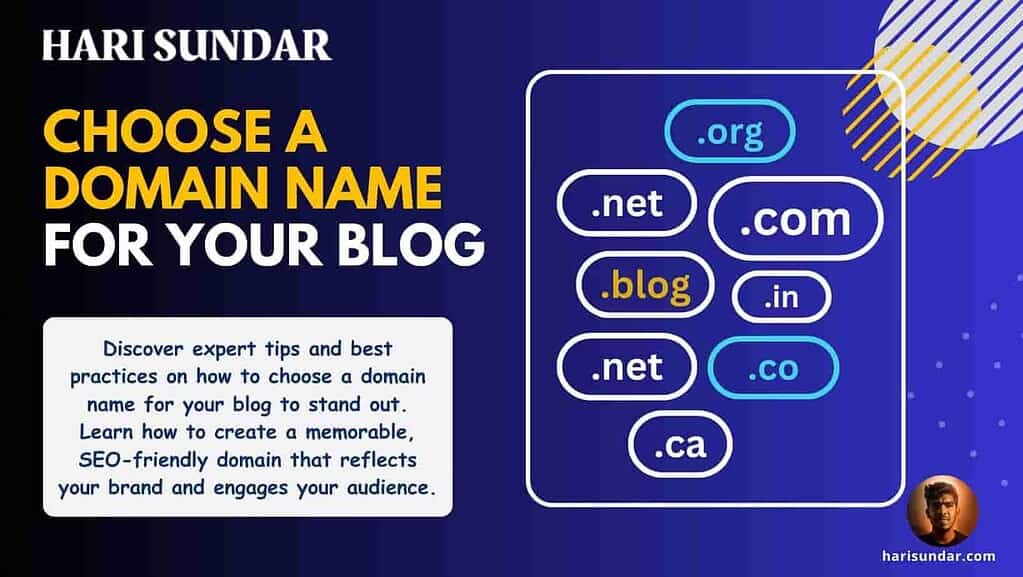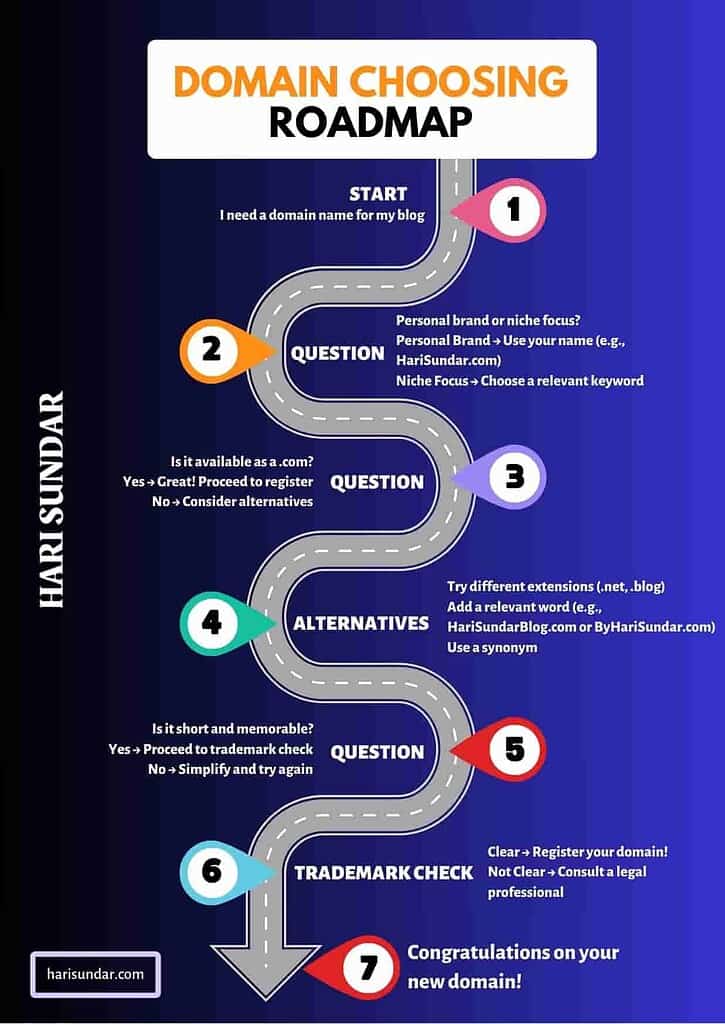Choose a Domain Name For Your Blog: Blueprint Inside! [2024]

Did you know that over 366.8 million domain names are registered worldwide as of 2023? With so many options, choosing the right domain name for your blog can feel overwhelming.
But don’t worry – I’ve been through this process before, and I’m here to share what I’ve learned along the way.
When I started my blogging journey, I made plenty of mistakes. However, after years of learning and refining my approach, I’ve discovered that using my own name as my domain was the key to building a sustainable personal brand.
Now, I’m here to help you navigate the world of domain selection and set your blog up for long-term success.
Here’s what we going to cover
🚀 Choosing your blog’s domain name is crucial for success
💡 Discover tips for creating memorable domain names
Explore domain extensions and their impact on your reach
Learn why personal branding domains (like your name) can be powerful
⚖️ Understand the pros and cons of using keywords in your domain
💪 Avoid common domain name mistakes and set your blog up for growth and success
Understanding the Importance of Your Domain Name
Your domain name is like your blog’s handshake – it’s often the first impression people get of your brand. Trust me; first impressions matter in the blogging world.
The role of your domain name in brand identity
Your URL is a crucial part of your blog branding. It sets the tone for everything else.
When I chose to use my name as my domain, it wasn’t just a simple decision – it was a strategic move to build a personal brand.
Suddenly, people understood that my blog was an extension of me, my experiences, and my expertise.
How your domain name impacts SEO and discoverability
Let’s talk SEO. While keyword-rich URLs can help with discoverability, you need to balance it with brand-ability.
I’ve seen blogs with domains like “best-urban-gardening-tips-2024.com,” and honestly?
They look spammy and are hard to remember. A good domain name strategy considers both SEO and user-friendliness.
First impressions: Why your domain name matters to readers
Remember, your domain name is often the first thing readers see. It sets the tone for everything else.
A well-chosen personal brand domain can pique interest and establish credibility. Think of it as your blog’s elevator pitch – you want it to be intriguing and informative in just a few words.
Key Characteristics of a Strong Domain Name
After making plenty of mistakes (and learning from them!), I’ve figured out what makes a domain name strong. Let me break it down for you.
Conciseness and memorability
Short and sweet is the way to go. My current blog, which uses my name, is much more effective than any lengthy domain I could have chosen.
It’s easier to remember, type, and share. Even, when they type my name, it gets registered in their mind not only as a blog but also as a person.
Because people mostly remember people more than any other random brand name.
When brainstorming blog URL ideas, aim for something snappy that sticks in people’s minds.
Relevance to your blog’s niche or topic
Your domain should give readers a clue about what your blog covers. Using a relevant domain name allows you to cover various topics while building a personal brand. It’s like a mini-billboard for your entire online presence.
Ease of pronunciation and spelling
I can’t stress enough how important pronunciation and spelling are. If you stumble saying your domain out loud, your readers probably will too. Keep it simple! Your name is usually a safe bet here.
Uniqueness and brand-ability
In the vast ocean of the internet, you want your blog to stand out. A unique, brandable domain name can help you do just that.
If you want to build a personal brand, you can use your name. Your name is inherently unique, making it perfect for building a personal brand that can evolve with you.
Avoid following trends that’ll date faster than last season’s fashion. Instead, aim for something timeless that resonates with your target audience.
Choosing a domain name is a crucial step in your blogging journey. It impacts everything from your brand identity to your SEO efforts. But don’t let it paralyze you.
Navigating Domain Name Extensions
When it comes to domain extension choices, there’s a lot to consider. Let’s break it down and see how different extensions can impact your blog’s success.

The power of .com and why it’s still king
In the world of domain name best practices, .com still reigns supreme. Why? It’s familiar, trusted, and often the first extension people try when looking for a website.
With .com, you have the power to rank globally and build an audience from any country. You can use it for almost any type of business or personal branding.
When to consider alternative extensions (.net, .org, .blog)
Sometimes, your perfect .com isn’t available. Don’t panic! Alternative extensions like .net, .org, or even newer ones like .blog can still work wonders for your brand identity in URLs.
For instance, if you’re running a non-profit education blog, a .org extension might actually boost your credibility.
The key is to choose an extension that aligns with your blog’s purpose and audience expectations.
Country-specific extensions and their impact on local SEO
If you’re targeting a specific geographic area, country-specific extensions can be a game-changer for local SEO domain strategies.
For example, using .co.uk for a UK-based blog can help you rank better in local search results. It works perfectly if you have a local business targeting a specific country.
Just remember, this might limit your international appeal. Local audiences can go to international blogs but international audiences might not go to a local or country-specific blog unless necessary.
So, consider your long-term goals when making this choice.
Incorporating Keywords: A Delicate Balance
Keywords in domains can be tricky. Let’s explore how to use them effectively without compromising your brand.
The pros and cons of using keywords in your domain
Keyword-rich URLs can boost your blog’s discoverability, especially for niche topics. However, keyword-stuffed domains can look spammy and lack uniqueness. It’s all about finding that sweet spot.
For example, we can take TomsGuide.com, which talks about everything from technology to fitness. That’s the power of a personal brand.
Because he is not the fitnessguy.com, talking only about fitness and pigeonholing himself in a tiny niche.
Here, TomsGuide, the blog name is attached to his identity, it gives so much power to pivot if one thing doesn’t work without quitting his blog. That’s what I did, started this blog as a personal brand using my name.
How to naturally integrate keywords without sacrificing brandability
The secret to brandable blog URLs is subtlety. Instead of cramming every keyword into your domain, focus on one or two that truly represent your blog’s essence.
For instance, “CityPlantLover.com” incorporates keywords naturally while still being catchy and brand-friendly. It’s about striking a balance between SEO-friendly domain names and memorable blog addresses.
When using your name as the domain, you can incorporate keywords in your blog’s tagline or site description instead.
Long-tail keywords vs. broad terms: Which is better for your domain?
While long-tail keywords can be great for content, they often make for clunky domains. Broad terms usually work better for domain name practices.
Compare “HowToGrowTomatoesInTheCity.com” with “CityTomatoes.com”. The latter is more versatile and allows for broader content coverage while still hinting at your niche.
Using your name as the domain allows you to cover a wide range of topics without being limited by specific keywords.
Long domains are harder to remember, type, and share. They also look cluttered on business cards and social media profiles. Aim for concise, punchy domains that capture your blog’s essence without rambling on.
Avoiding Common Domain Name Pitfalls
Let’s talk about some domain name mistakes I’ve seen (and made) over the years, so you can avoid them in your blog domain selection process.

The dangers of hyphens and numbers in domain names
Hyphens and numbers in domains can confuse users, make your URL harder to remember, and even appear spammy.
I made this mistake with my old blog. Stick to clean, simple domain names for better brand consistency and user experience.
Steering clear of trademarked terms and potential legal issues
Always do your homework with domain name legal considerations. Use a domain name availability checker, and when in doubt, consult with a legal professional. It’s better to be safe than sorry!
Tools and Techniques for Domain Name Brainstorming
When it comes to blog domain selection, the brainstorming process can be both exciting and overwhelming. Let’s explore some effective techniques to help you find that perfect domain name.
Leveraging domain name generators and suggestion tools
Domain name generators can be a goldmine for unique blog URL ideas. These tools use algorithms to combine keywords, prefixes, and suffixes, often producing brandable blog URLs you might not have thought of on your own.
Some popular domain name generators include:
- Nameboy
- Panabee
- Shopify’s Business Name Generator
Remember, these tools are just a starting point. Use them to spark your creativity, but always evaluate the suggestions critically to ensure they align with your blog branding tips.
Using thesaurus and word combination techniques
Sometimes, the perfect domain name is just a synonym away. Thesaurus-based domain name brainstorming techniques can help you discover fresh perspectives on your blog’s core concepts.
For example, instead of “CityGardening.com,” you might find “MetroHarvest.com” or “UrbanCultivate.com.”
Try these steps:
- List key terms related to your blog niche
- Use a thesaurus to find synonyms for each term
- Mix and match these words to create unique combinations
This method can lead to some truly creative and memorable blog addresses that still clearly convey your blog’s focus.
How to check domain availability and alternatives
Once you have a list of potential names, it’s time to check their availability. A reliable domain name availability checker is crucial at this stage.
Tools like GoDaddy or Namecheap offer quick checks and often suggest alternatives if your chosen name is taken.
When checking availability:
- Try different domain extension choices (.com, .net, .blog, etc.)
- Consider slight variations (e.g., adding “blog” or “writes” to your name)
- Look out for trademark-safe domains to avoid legal issues
Remember, while .com is often preferred, other extensions can work well too, especially if they align with your blog’s purpose (e.g., .org for non-profits).
Future-Proofing Your Domain Name Choice
Choosing a domain name isn’t just about what works now – it’s about selecting a name that will grow with your blog. Let’s dive into future-proof website naming strategies.
Considering the longevity of your chosen name
When selecting a domain name, think long-term. Will your chosen name still be relevant in 5, 10, or even 20 years?
Avoid domain name trends that might feel dated quickly. Instead, focus on timeless concepts related to your niche.
For example, “TrendyUrbanGardens2024.com” might seem great now, but it’ll be outdated by next year. A name like “CityGreenSpace.com” has more staying power and allows for evolving content over time.
Consider these factors for longevity:
- Avoid year numbers or current trends in your domain
- Choose broader terms that allow for topic expansion
- Think about the domain name and blog success correlation – a timeless name can contribute to long-term growth
Anticipating potential pivots or expansions in your blog’s focus
Your blog’s focus might evolve, so choose a domain name that allows for growth.
I started this blog to teach digital marketing, especially blogging and SEO. As my expertise grows, I can branch out to other areas in digital marketing.
In the future, I can even pivot and talk about health and wellness, productivity and mindset, and anything I want as my expertise grows.
So, my blog gives me the flexibility to cover various topics and pivot as my interests expand.
Tips for anticipating future changes:
- Choose a name that relates to your broader niche, not just your current specific focus
- Consider domain name and brand consistency across potential future topics
- Think about international blog domain strategies if you might expand globally
Securing variations of your domain name for brand protection
Once you’ve chosen your primary domain, consider securing variations to protect your brand.
This strategy, often part of domain name portfolio management, can prevent others from using similar names that might confuse your audience.
Variations to consider:
- Common misspellings
- Different domain extensions (.net, .org, etc.)
- Variations with additional words (e.g., “blog,” “writes,” “online”)
For example, my main domain is “harisundar.com,” I might also secure:
- harisundar.net
- harisundar.org
- harisundar.in
While this requires a bit more investment upfront, it can save you headaches down the road and contribute to a stronger brand identity in URLs.
Remember, your domain name is a crucial part of your blog’s brand identity and can significantly impact your blog’s discoverability through URLs. Take the time to brainstorm, check availability, and think about the future.
A well-chosen domain name can be a valuable asset in your blogging journey, contributing to your blog’s success and making it easier to build a strong, recognizable brand in the crowded online space.
Conclusion
Alright, you’ve made it through the domain name jungle! Choosing the perfect domain isn’t just about picking a catchy name – it’s about setting the foundation for your blog’s success.
Trust me, I’ve been there, done that, and got the T-shirt (and a few domain-related headaches along the way).
Remember, your domain name is often the first handshake between you and your potential readers. Make it firm, memorable, and for the love of all things digital, make it easy to spell!
As you set on your blogging journey, keep these key points in mind:
- Consider using your name for a strong personal brand
- Keep it short, sweet, and relevant to your niche
- Think long-term – will your domain still make sense in 5 years?
- Balance SEO-friendliness with brand-ability
- Don’t be afraid to get creative, but keep it simple
- Always, always check for trademark issues
Your domain name is an investment in your blog’s future. Take the time to get it right, and it’ll pay off in the long run.
Armed with these tips and your newfound domain name wisdom, it’s time for you to take action. Head to a domain registrar, start brainstorming and claim your perfect slice of internet real estate. Your future readers are waiting!
And hey, if you want to dive deeper into the world of blogging, learn to start a blog and become a successful blogger. Trust me, choosing your domain name is just the beginning of an exciting journey.
Happy domain hunting, and here’s to your blogging success! Now go make your mark on the internet – I can’t wait to see what you create.
FAQs: Choose A Domain Name For Your Blog
Is it better to use my name or a niche keyword for my blog domain?
From my experience, using your name as a domain (like I did with harisundar.com) gives you more flexibility. It lets you cover various topics and pivot if needed, without being boxed into a specific niche.
Plus, it builds a strong personal brand. But if you’re laser-focused on one niche, a relevant keyword can work too. Just keep it short and memorable.
How important is getting a .com domain?
While .com is still king, don’t stress if it’s not available. I’ve seen blogs thrive with other extensions like .net or .blog. The key is picking an extension that fits your brand and is easy for readers to remember. If you’re targeting a specific country, a local extension (like .co.uk) can boost your local SEO.
Should I use hyphens or numbers in my domain name?
Honestly? I’d avoid them. I made the mistake of using numbers. It may confuse people and it would be like a spammy site. Stick to clean, simple domains. They’re easier to type, remember, and share. Plus, they look more professional on business cards and social media.
How can I check if my domain name idea is already trademarked?
Always do your homework here. Use a domain availability checker first, then dig deeper with the trademark databases. When in doubt, it’s worth consulting a legal pro. Trust me, it’s better to be safe than sorry when it comes to potential legal issues.
What if the domain name I want is already taken?
Don’t give up! Try variations, different extensions, or add words like “blog” or “writes” to your name. Use domain suggestion tools for fresh ideas. Remember, a slightly different domain is better than a confusing or legally risky one. Keep brainstorming – your perfect domain is out there!
How long should my domain name be?
Shorter is usually better. Aim for something snappy that people can easily type and remember. Long domains are harder to share and more prone to typos. My rule of thumb? If it’s a mouthful to say out loud, it’s probably too long for a domain.
Can I change my domain name later if I don’t like it?
You can, but it’s a hassle. It affects your SEO, and branding, and can confuse your audience. That’s why it’s crucial to choose a domain that can grow with your blog. Think long-term – will your domain still make sense in 5 years? Pick something you’ll be happy with for the long haul.






